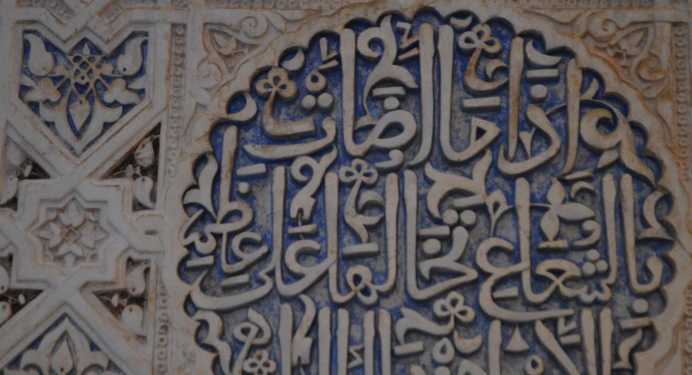
A place of consequences
The Alhambra of Granada
Perhaps there never was a monument more characteristic of an age and people than the Alhambra; a rugged fortress without, a voluptuous palace within; war frowning from its battlements; poetry breathing throughout the fairy architecture of its halls.
Washington Irving, Tales of the Alhambra, 1832
Spain’s last Moorish king, Muhammad XII of Granada (known as ‘Boabdil’ to the Castillians), glanced back at the place of his birth, the citadel of Alhambra, for the final time and sighed. It is a moment in history that has been portrayed in numerous works of art, such as ‘The Capitulation of Granada’ by Francisco Pradilla Ortiz, and is the title of a Salman Rushdie novel, ‘The Moor’s Last Sigh’. ‘Weep like a woman for what you could not defend as a man’, Boabdil's mother is believed to have told him, as Moorish rule over the Iberian Peninsula stretching back to 711 came to a largely undignified end.
Today’s visitor to Alhambra sighs not only at the steep ascent via the Gate of the Pomegranates (Puerta de las Granadas), with its triumphant Roman columns, but at the magnitude and majesty of this UNESCO World Heritage Site. Initially constructed back in the ninth century and ultimately abandoned in the eighteenth, save by those who plundered its relics, it was Washington Irving’s 1832 ‘Tales of the Alhambra’ which sparked what many judge to be a meticulous and faithful reconstruction.
Perched like a bird of prey over the city of Granada, with the white peaks of the Sierra Nevada mountains as its defensive backdrop, the Alhambra’s imposing exterior walls conceal the sumptuousness of its gardens and serenity of its water features, which even in January refresh the surroundings. Moorish poets dubbed it 'a pearl set in emeralds' because of the colour of its constructs and surrounding conifers. The Palacio de Generalife, which served as the Nasrid dynasty's summer palace, epitomizes this tranquility and escapism through its symmetry and clean lines, achieved through meticulous planning and relentless pruning.
Onwards to the Nazrid Palaces, where we are whisked from one room to another in a disorientating manner. Time feels insufficient to study the patterns, contours, nuances, symmetries, and incongruences of the inner sanctuaries and epic courtyards. I photograph seemingly endless fragments of ceramic tiles, mosaics, scripts, and engravings, whilst trying to absorb the entire composition. There are stylised depictions of people and animals; widely held to be forbidden within Islam, but which are in fact a celebrated facet of many secular Islamic cultures. Floors, walls, and ceilings - no inch of space has been left unaffected by the craftsmanship that has embellished this place.
It is a forlorn and exhausting task. As the light shifts during the course of the day, so to the relative balance of its competing strands; some of which will be over-exposed, others cast in semi- or complete darkness. Days and weeks of subsequent reflection only further exacerbate the sense of frustration fuelled by this flummoxing fortress, especially when one considers all that has been destroyed or modified over the course of centuries.
The Hall of the Ambassadors alone could occupy one’s senses and curiosity for aeons, not only thanks to its remarkable ceiling which represents the Seven Heavens of the Islamic Paradise, but also because of the spectacular views it offers over the surrounding landscape. Then there are the seemingly perilous intricacies of Patio de los Leones (named after its Lion Fountain), which mixes Moorish and Christian influences, that have somehow withstood the elements of man and nature. The Sala de los Abencerrajes, meanwhile, with its eight-pointed honeycomb (known as 'mocárabe') and twelve-sided fountain, almost redeems those responsible for the massacre of thirty-six noblemen from the Abencerrajes family, in whose honour the room is allegedly named. Each deserves a separate journal entry of their own, providing the chronicler can overcome his or her sense of illustrative inadequacy.
It remains a complex which is not yet - and indeed may never be - fully understood. We’re told how large swathes of the Arabic script engraved into the walls are yet to be translated. Of those that have, the motto of the Nasrid dynasty - ‘there is no victor but Allah’ - predominates. I pity the local school children, deprived of history teachers by the tourists hungry for local guides steeped in the stories and aura of the Alhambra. Their enthusiasm belies the daily repetitiveness of their circulations, replicating the very fountains and cascades that impart minute droplets into the air.
The final surrender of the Nasrid dynasty and the Emirate of Granada (over two hundred and fifty years after the fall of Córdoba) and the end of Al-Andalus in 1492 sanctioned the voyages of Christopher Columbus; with the new knowledge and wealth acquired furnishing the rule of Ferdinand and Isabella, the Catholic Monarchs who de facto unified Spain.
In parallel, books were burnt and knowledge lost to eternity. Immense contributions to the collective knowledge of humanity were turned to cinders, despite guarantees that the diversity of this place (its libraries, mosques, faiths, and traditions) would be safeguarded. The Alhambra Decree (also known as the Edict of Expulsion) ordered the almost immediate expulsion of practising Jews. From the citadel (known as the 'Alcazaba') - one of the oldest parts of Alhambra - one can look out over the neighborhood of Albaicín, whose narrow, winding streets are one of the other lasting remnants of Moorish architecture.
The Alhambra is a place of consequences, many of which still reverberate to this very day, both here and beyond; a place that one will constantly refer back to, or be referred back to, in the course of reflections upon contemporary Europe, north Africa and beyond. Fortunately, it is a place which has been faithfully and perseveringly retrieved from the past, and whose meaning is still being deciphered even to this very day, for the benefit of present and future generations, by those for whom Alhambra's bewitching qualities will never wane.
Ian is a writer based in the Balkans. He is the author of 'Dragon's Teeth - Tales from North Kosovo' and 'Luka'. Follow Ian on Twitter @bancroftian.
Currently in: Belgrade, Serbia — @bancroftian
